1902 Clover Leaf Egg en de vermiste surprise
Tijdens het werken aan de identificatie van de waarschijnlijke surpise van het 1907 Rose Trellis Egg, zag ik dat de Keizerin in dezelfde foto een broche of speld droeg die leek op een klavertjevier. Ei-liefhebbers weten wat dat betekent! De surprise van het 1902 Clover Leaf Egg. Zou dat mogelijk zijn? Of is het gewoon té mooi om waar te zijn?
Aan de andere kant geldt hier hetzelfde als voor het 1907 Rose Trellis Ei medallion; hoeveel klavertjes vier juweeltjes zou de Keizerin gehad hebben in 1908? En droeg ze dus niet alleen een portretje van haar enige zoon, maar van alle vijf haar kinderen op die dag in juni 1908?
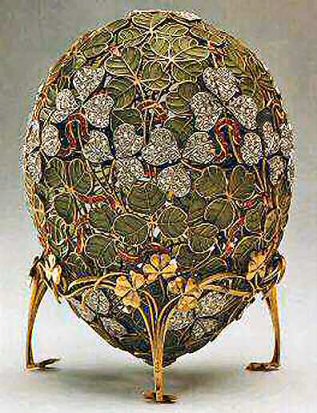
1902 Clover Leaf Egg - Courtesy Kremlin Museums
Hieronder is de foto van Keizerin Alexandra Feodorovna tijdens het bezoek aan Reval, nu Tallinn in Estonia, in 1908. Volgens mijn mede researcher Greg Daubney en mijzelf draagt zij daarop een medallion waarvan wij denken dat het de surprise is van het 1907 Rose Trellis Ei. Zie dat verhaal hier!
Nu snel voorwaarts, of liever nog, achterwaards, naar het 1902 Clover Leaf Egg.
Zoals je kunt zien op de afbeelding hieronder hebben we een beetje hulp nodig. De afbeelding is té vaag en korrelig om zelfs maar te kunnen beoordelen of het juweel gemaakt zou kunnen zijn door Fabergé. Maar hoe meer ik kijk naar de plaatjes, hoe meer ik denk te zien; tenminste drie portretjes op de blaadjes van de klaver, ik zie zelfs diamantjes aan de randen. En met een beetje verbeelding zie ik zelfs gezichtjes van (Keizerlijke) kindertjes...
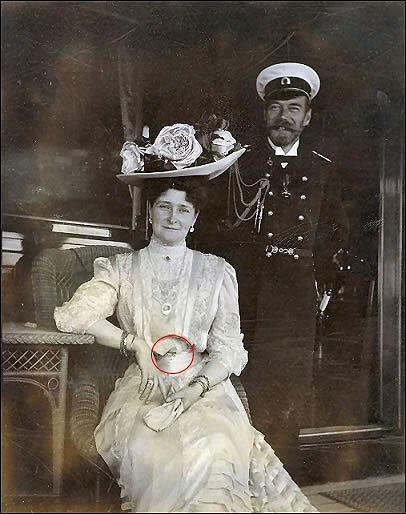
(Photo courtesy Humus777) Klik afbeelding voor groot formaat.
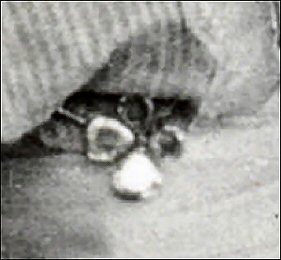
(Vergroting van het juweel dat de Keizerin draagt)
In 1902 toen het Clover Egg werd gepresenteerd, had het Keizerlijke echtpaar vier kinderen. De jongste, Anasasia, was geboren in 1901. De vier dochters werden vereeuwigd in verf op een miniatuurtje in een houten (Fabergé?) lijstje. Dit lijstje vond Greg Daubney op internet. Ik heb helaas de bron niet kunnen achterhalen, en vond het alleen op Pintrest. De anzichtkaart rechts van het lijstje is een officiële foto gemaakt door hoffotograaf L. Levitsky op 16 augustus 1901. Deze kaart vond ik op Les Derniers Romanov.com onder 1901. Wanneer je daar op die pagina op de kaart klikt krijg je een vergroting en kun je de tekst lezen.
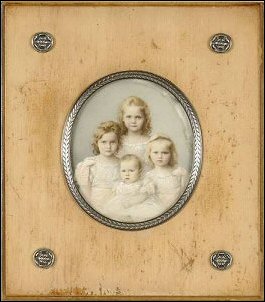 x
x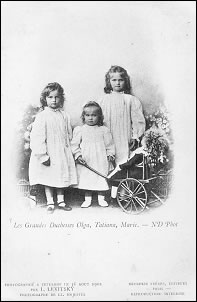
Ik denk dat het miniatuurtje in het houten lijtje is gebaseerd op de 1901 foto, met baby Anastasia aan het miniatuurtje toegevoegd. Ze was té jong, twee maanden pas, toen de foto werd gemaakt.
Ik denk dat deze zelfde foto werd gebruikt voor de miniatuurtjes in de broche, of speld waar de Keizerin het klavertjevier voor gebruikte. Van het 1899 Pansy Egg weten we dat Fabergé in staat was om deze ontzettend kleine miniatuurtjes te maken!
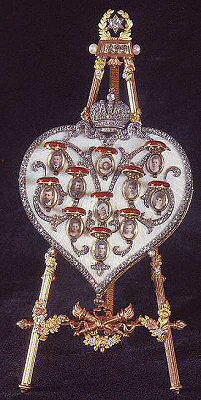
(Miniatuurtjes van het 1899 Pansy Egg)
Fabergé wetenschapper Ulla Tillander-Godenhielm schreef mij over de juwelen die the Keizerin draagt bij deze gelegenheid: It is more than logical that the empress could not 'favourize' one of her children, albeit the boy was the long-awaited heir to the throne. Of course she would also wear a jewel linked to her four daughters on this state visit!
The Reval visit was a 'family' visit in the sense that the visitors were the closest relatives of the imperial family and the conversation naturally to a great extent would have been news about the children. Alexandra had very good taste in both costumes and in the smart way of wearing jewellery - how elegant to wear the four clover brooch at the waistline! These pieces of jewellery were real 'conversation pieces', immediately sparking off delightful comments and admiration centered on the children.
Zoals ik al zei, moet je een beetje verbeelding hebben en tenzij we een goede foto of afbeelding vinden waarop de Keizerin hetzelfde klavertjevier draagt, of beter nog een foto van het juweeltje zelf, zullen we nooit met zekerheid weten of dit de surprise van het 1902 Ei was.
Dus we hebben hulp nodig, van jullie Romanov en Fabergé liefhebbers! We zoeken een goede foto van een klavertjevier, bij voorkeur gemaakt door Fabergé, met 23 diamonds, rose-cut diamonds and 4 miniatures, als was geschreven door Fabergé op de faktuur van het 1902 Imperial Easter Egg.
De beloning is eeuwige dankbaarheid van alle Fabergé Imperial Egg liefhebbers!
Update januari 2019
Bij Christies in London is in november 2018 een gouden broche verkocht in de vorm van een klavertjevier, gemaakt door Fabergé met werkmeester-teken van Mikhail Perkhin. Het ontwerp van deze broche lijkt erg op het juweeltje dat de Keizerin droeg in Reval in 1908 and is misschien een aanwijzing dat die broche of speld inderdaad gemaakt is door Fabergé.
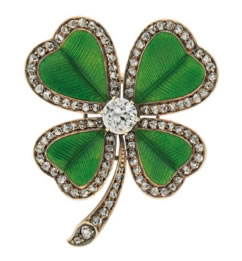
Klavertjevier broche van Fabergé (Courtesy Christies)
Annemiek Wintraecken met hulp van Greg Daubney
Pagina gemaakt 4 november 2017
Update zomer 2019 -1902 Clover Leaf Egg Vermiste Surprise Geïdentificeerd? Een Team Prestatie.
![]() In dit verhaal geven twee Fabergé enthousiastelingen aanstekelijke informatie over deze surprise. (Geschreven voor en eerst gepublieerd in de Fabergé Research Newsletter, Spring-Summer 2019).
In dit verhaal geven twee Fabergé enthousiastelingen aanstekelijke informatie over deze surprise. (Geschreven voor en eerst gepublieerd in de Fabergé Research Newsletter, Spring-Summer 2019).
Annemiek Wintraecken (The Netherlands) writes: In October 2017, Fabergé egg enthusiast Greg Daubney from the United Kingdom sent me a photograph of Empress Alexandra Feodorovna wearing a medallion around her neck. He suggested it might be the missing surprise (later identified with a portrait of the Tsesarevich Alexis) for the 1907 Rose Trellis Egg. While studying this image, I noticed the Empress was also wearing a brooch or pin resembling a four-leaf clover on her waist cummerbund. Could it be the missing surprise for another egg, the 1902 Clover Leaf Egg by Fabergé? How many four-leaf clover jewels with four tiny portraits could the Empress have owned? Unfortunately, the enlarged image was unclear and too vague to determine if the jewel was by Fabergé, but the more I looked at the object, the more I realized there were at least four miniature portraits on clover leaves bordered by diamonds. And with a little bit of imagination one can even see the faces of the four daughters of the Imperial couple, Emperor Nicholas II and his wife, Alexandra Feodorovna.

Juan F. Déniz (Gran Canaria, Canary Islands) writes: In June 2018, I found an illustration of a clover leaf in an article entitled “Unscrambled Eggs” by Geoffrey Munn1 with this caption: “An undated design for a jewel in the form of a four-leaf clover set with diamonds. Each leaf has an open aperture, probably for miniatures or photographs. From the Holmström Archive. Wartski, London.” I recalled Annemiek Wintraecken’s research on the 1902 Clover Leaf Egg and her hypothesis about the missing surprise, both discussed on her website.

I was not certain the ornament was created by Fabergé, since brooches or similar jewels in the form of a clover were a fashionable accessory for women during Fabergé’s time. After lining up the design sketch next to the enlarged brooch or pin in the shape of a clover leaf worn by the Empress in 1908, the similarity became apparent based on the different sizes of the leaves and their shapes. Is Holmström’s design sketch the prototype for Alexandra’s accessory?
Tatiana Muntian in her essay in the exhibition catalog for the first major Fabergé exhibition in the former Soviet Union in 19893 states:
“The ‘surprise’ of the Clover Egg from the Kremlin is lost but some archive papers make it clear that there was a large ‘clover leaf of four foils with 23 diamonds, roses and four miniature portraits.’ One may only guess that the portraits were those of [the] Tsar’s daughters. …” Muntian concludes with an explanation of the symbolic meaning of the four-leaf clover or quatrefoil.
The 1902 Egg is included without its surprise in the detailed 1909 inventory of the Imperial family’s private apartments by Nikolai Dementiev, inspector of the premises of the Winter Palace. Was the surprise “in use” by the Empress as a piece of jewelry to be worn? The Clover Egg with its stand is just 3 7/8 in. (9.8 cm) in height, so its surprise had to be quite small. Illustrated below are the prongs for the surprise:

The authors contacted Geoffrey Munn, managing director emeritus, Wartski, London, with their hypothesis. His response was as follows:
“As I said in the article the quatrefoil is, for obvious reasons, a very popular device in 19th and early 20th century. It not only stands for luck in love, but is well established in Christian lore. However, since the surprise is missing and there is a quatrefoil worn by the Empress there is every reason to think this is the very one. Bravo for the discovery to both Juan and you!”
An effort to find the surprise pictured in auction catalogs from 1934 to the present has not yielded any results. A quatrefoil dated 1890, without spaces for photographs and yet similar to the Holmström design sketch was made in the Mikhail Perkhin workshop. It sold at auction, Christie’s London, November 26, 2018, Lot 208. (See above, update January 2019).
The essay above was written for and first published in the Fabergé Research Newsletter, Spring-Summer 2019. The original article has additional images you might like to see (here).
Page updated or corrected: December 10, 2019
